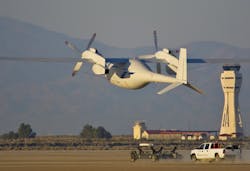Boeing Phantom Eye UAV completes first autonomous flight, sustains damage on landing
ST. LOUIS, 5 June 2012. Boeing's [NYSE: BA] Phantom Eye unmanned aerial vehicle (UAV) completed its first autonomous flight June 1 at NASA's Dryden Flight Research Center at Edwards Air Force Base, Calif.
The liquid-hydrogen powered aircraft's flight lasted 28 minutes. The Phantom Eye reached an altitude of 4,080 feet and a cruising speed of 62 knots. After touching down, the vehicle sustained damage when the landing gear dug into the lakebed and broke.
The Phantom Eye is a high-altitude, long-endurance, hydrogen-powered UAV. The Phantom Eye is based off the Boeing Condor, which was introduced in the late 1980s. The liquid-hydrogen propulsion system that powers the aircraft completed an 80-hour test in March 2010.
Phantom Eye is part of a series of Boeing-funded rapid prototyping programs, which include Phantom Ray, Echo Ranger, ScanEagle Compressed Carriage, and an associated Common Open Mission Management Command and Control (COMC2) system for managing all of the company's unmanned assets.
The flight took place after a series of taxi tests in April that validated ground guidance, navigation and control, mission planning, pilot interface and operational procedures. The flight demonstrated Phantom Eye's initial handling and maneuvering capabilities.
Phantom Eye's liquid-hydrogen propulsion system enables the aircraft to stay on station for up to four days while providing persistent monitoring of areas at a ceiling of up to 65,000 feet, creating only water as a byproduct. The demonstrator, with its 150-foot wingspan, is capable of carrying a 450-pound payload.
Boeing's portfolio of UAV solutions includes the A160T Hummingbird, H-6U Unmanned Little Bird, S-100 Camcopter, Integrator, ScanEagle, Dominator, Phantom Eye and Phantom Ray.
